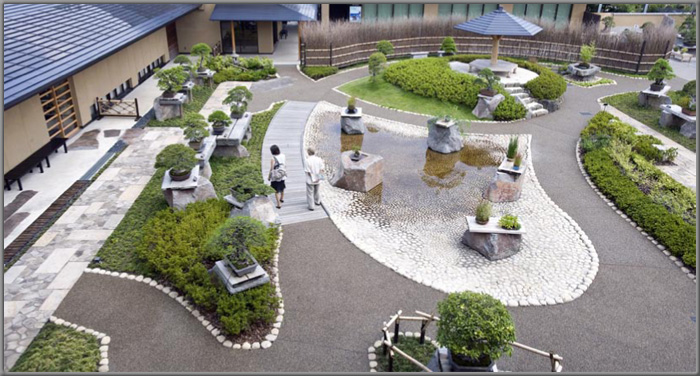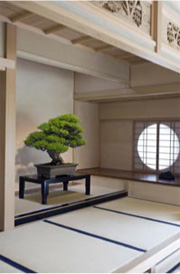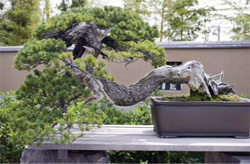Home > Highlighting JAPAN > Highlighting Japan SEPTEMBER 2011 > The Omiya Bonsai Art Museum, Saitama
Highlighting JAPAN
THE NATION'S MUSEUMS

Caption: Visitors look around the main display area in the courtyard of the Omiya Bonsai Museum of Art, Saitama.
Credit: ROB GILHOOLY
The Omiya Bonsai Art Museum, Saitama
Julian Ryall visits the Omiya Bonsai Art Museum in Saitama, a heartland of bonsai nurseries since the 1923 Great Kanto Earthquake.

A formal zashiki Japanese-style room at the Omiya Bonsai Museum of Art
Credit: ROB GILHOOLY
Only opened in 2010, it is the world's first publicly operated museum dedicated to the creation of miniaturized plants and includes examinations of the culture behind bonsai, the pots that are used to best display them, the tools to create their distinctive shapes and documents, photos and pictures that explain their history.
The work that is being done here to learn more about bonsai and preserve its traditions is important; for the novice to a cultural heritage that has become synonymous with Japan, the impact can be breathtaking.
The museum has an indoor area, where the basic concepts of bonsai are explained and a number of traditional ukiyo-e woodblock prints, old books and stones arranged in trays to replicate landscapes, are on display, before visitors emerge into the garden.
Before me is a forest of more than a dozen spruce trees that are clearly mature specimens but stand only a meter or so high. The bark on their trunks is mottled and peeled away in places; their deep-green needle foliage is immaculately symmetrical. Around the base of their trunks, and cascading over the edge of the broad tray in which they have been cultivated, are brighter green fern leaves that catch the breeze.
It is clear, as I admire this remarkable work, that someone has lavished a great deal of care and attention on these plants—in many cases over a period of more than 100 years. The attention to detail is incredible as not a leaf nor a branch is out of place.
According to the museum, the key to appreciating bonsai is to imagine a great landscape that has been compressed into a pot. The viewer should not just focus on the shape of the bonsai, but on each and every element of it, including the way the roots spread out from the base of the tree, the way the trunk rises, the individual branches, the leaves.

The Japanese five-needled pine bonsai "Seiryu"
Credit: ROB GILHOOLY
The rest of the garden is similarly impressive. A black pine has been trained into a straight-trunk design, while another has a gnarled and weathered trunk that corkscrews away from its roots, giving the tree the appearance of trying to escape its container.
Numerous other species have been similarly miniaturized—wisteria, cherry, Korean hornbeam, Japanese apricot and maple—and the museum regularly rotates the plants on display to show them at their most impressive. With autumn approaching, maples will soon be taking on the deep reds and russets and will be well worth seeing.
The garden includes water features, and rock pedestals are used to hold the bonsai plants' pots. The museum has an extensive collection of such pots and trays, many several hundred years old, that can be viewed in the exhibition room. Nearly as much work has gone into the design and decoration of these containers as into the bonsai themselves, with many depicting landscapes, dragons, scrolled peonies, cranes and lengths of bamboo.
The collection is drawn from that of the former Takagi Bonsai Museum of Art in Tokyo. This part of Saitama Prefecture was chosen to host the facility because it became home to many of Tokyo's bonsai-raising families after the Great Kanto Earthquake of 1923, when they moved out of Bunkyo Ward and other areas. The museum lies adjacent to the Omiya Bonsai Village which these families settled.
For a rank amateur, such as myself, actually being let loose on one of these masterpieces with clippers or wire would be a terrifying experience, but the museum also hosts workshops for anyone interested in trying their hand at a hobby that is both creative and therapeutic.
| Access and Admission | |
| Address: | The Omiya Bonsai Art Museum, 2-24-3 Toro-cho, Kita Ward, Saitama City, Saitama, 331-0804. |
| Tel: | +81 (0)48 780 2091. |
| Website: | https://www.bonsai-art-museum.jp/en/ |
| Opening Hours: | From 9 a.m. to 4:30 p.m. from March to October and from 9 a.m. to 4 p.m. between November and February. The museum is closed on Thursdays and over the year-end and New Year holiday periods. It is also closed on certain days to enable the staff to change the exhibitions. Check with the museum in advance. |
| Admission: | Tickets are 300 yen for adults, 150 yen for university and high school students and senior citizens, and 100 yen for younger children. |
© 2009 Cabinet Office, Government of Japan






